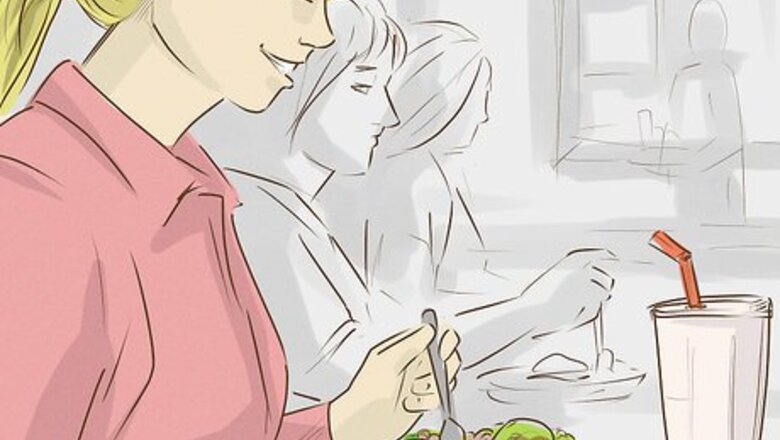
views
There is no magic solution to stop cutting, but it’s important to be kind to yourself and not punish yourself mentally. If you want to begin the process of recovery, there are ways you can get help to stop cutting yourself.
If you or someone you care about is contemplating cutting, please call one of the emergency numbers listed in the Additional Resources section at the end of the article.
Overcoming the Urge

Go somewhere you can't cut yourself. If you are feeling the urge to cut yourself, go somewhere it is harder to do. This can be some place public like a shop or the living room of your home with your family or your roommates. This will make it harder for you to give in to the urge to cut. It also might make you feel better, especially if you are around people who love and support you.
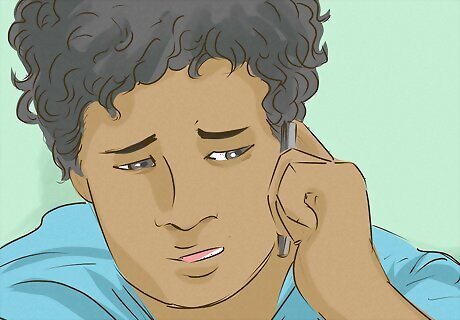
Call someone. If you're alone in your house or are unable to leave, call someone you like to talk with when you get the urge to cut. This can be a family member, a trusted friend, or a hotline. It might be helpful to create a phone list of people you can call. You can also program needed numbers into your phone. There are many hotlines you can call or text for help. One is 988, a 24-hour crisis lifeline for those who are about to self-harm or are in an emergency situation. You can also call 1-800-334-HELP, the Self Injury Foundation’s 24-hour national crisis line. Also try 1-800-DONT-CUT, which provides information about self-harm. If you hurt yourself or want to see a doctor, call 1-800-366-8288, which is S.A.F.E. Alternatives’ information line for immediate support and referrals to a local physician. If you are in the UK, you can call the Samaritans at 116 123, which is an agency that runs 24/7 and is dedicated to moments when you want to self-harm. You can also call Childline, a hotline for children and teens at 0800 1111. Both numbers are free from mobiles and landlines and neither will appear on your phone bill.

Distract yourself. One great way to avoid self-harm is to distract yourself. Not every distraction technique works for everyone, so you may need to try a few before you find which one works for you. Sometimes the trigger or urge can be different depending on your feelings or the situation, which means your response to prevent or stop self-harm will also be different. Try the butterfly method. When you have the urge to cut, draw a butterfly where you want to harm yourself and name it after a loved one or someone that wants you to get better. If you cut, the butterfly dies. You have to wash it off. If it wears off and you didn't cut, it is released into the wild to be free. Another idea is the pen method. Grab a pen and draw lines, squiggles, peace signs, or any symbol all over where you would've cut. When you're done, count the lines. That's how many scars you won't have. If these don’t work, try to brush or style your hair, make a cup of tea, count up to 500 or 1000, work on a puzzle or mind game, go people watching, play a musical instrument, watch TV or a movie, paint your nails, organize something like books or your closet, make origami to occupy your hands, be active, play a sport, take a walk, make up a dance routine, or do an art project or color in a picture. The possibilities are endless. It just has to be something that will adequately distract you.

Delay cutting. Whenever the urge to cut arises, delay the cutting. Start with a small amount of time such as 10 minutes and increase the time you wait each time. While you wait, think about the scars you don’t want and about how you don’t have to hurt yourself even though you're thinking about it or maybe want to do it. Repeat affirmations to yourself, such as “I don’t deserve to be hurt,” even if you don’t believe it at first. Remember that you always have the choice not to cut. The decision is truly up to you.
Learning Coping Strategies

Try the five senses technique. Coping skills are necessary for recovery. They help address the urges and often release the same feel good chemicals, called endorphins, in your brain that are released during self-harming. One common self-soothing technique is called the five senses technique, which provides a way to a helpful state of mind to address the painful or extreme feelings leading to self-harm. Start in a comfortable position, either sitting on the floor with your legs crossed or in a chair with your feet planted flat on the ground. Start focusing on your breathing. Next, start to bring awareness to each of your senses. Spend about one minute on each sense, focusing on only one at a time. Hearing: Focus on external sounds. Are they cars going by, people talking? Next, focus on internal sounds. Can you hear your breathing or digestion? As you focus on hearing, did you notice anything you did not before? Smelling: What do you smell? Is there food near you? Or maybe flowers outside? You might notice smells you did not before. Try closing your eyes to sharpen your other senses. Seeing: What do you see? Can you see out a window? Take notice of details such as colors, patterns, shapes, and textures. Tasting: What do you taste? Notice anything you can taste in your mouth, maybe from a morning coffee or your lunch. Move your tongue around to engage your taste buds, checking for any additional tastes you encounter. Touching: Feel the sensation of your skin being touched. This can be from the carpet under your feet or legs, the clothes on your skin, or the air moving across your face. Feel the chair you are sitting in.

Mediate or pray. Meditation or prayer might seem like a silly practice, but scientific studies have been done that shows meditation improves positive emotions, satisfaction, health, and happiness. It also decreases anxiety, stress, and depression. There are many different types of mediation, but the goal of all mediation is about calming the mind. Start in a comfortable seated position. Have a single point to focus on. This can be visual, such a fixed point in the room, auditory, such as a repeated single word or prayer, or physical, such as counting beads on a rosary. While you are focusing on the repeated task or stationary object, your mind will wander. When you notice your thoughts wandering, let the thought go and bring your concentration back to your focus point. This might sound easy, but focusing the mind is challenging. Do not be disappointed if you can only focus for a few minutes at first. Keep trying until you can spend hours releasing your thoughts and clearing your mind.

Start breathing exercises. Breathing is a natural response that we can control. Research shows that practicing breathing control has a positive impact on your stress response. The same stress response can be triggered when you feel the need to self-harm. Learning new skills might help you take control of your triggers. Try even breathing. This is a simple technique where you count to five while inhaling, hold for five counts, and take five counts to exhale. Focus on each part of your breathing.

Use relaxation techniques. There are multiple kinds of relaxation techniques that you can use. Try an imagery exercise, where you create an imaginary safe place where you don’t want to self-harm. Create a picture in your mind. The image should be peaceful or remind you of a happy memory. It might be easier to have a picture of a safe place printed out and to focus on it instead of one in your mind.

Try progressive muscle relaxation (PMR). Progressive Muscle Relaxation is a type of coping skill that focuses on tensing and relaxing different muscle groups. One benefit of PMR is that it helps you become more aware of physical sensations in your body. Start in a comfortable position that allows you to focus on different muscle groups. Most people find sitting or lying down the easiest to start. Next, focus on one group of muscles that you can tense and then relax. Tense these muscles for five seconds, squeezing just the muscle group you are working on at that moment. After five seconds, relax all of the muscles in that area and stay relaxed for 15 seconds. Then move on to the next muscle group. Repeat this multiple times a day if needed. Isolation of particular muscle groups can be difficult, but it gets easier with practice. Common areas include your face, hands and arms, stomach or middle section, and legs and feet. Wear loose fitting clothing so you are comfortable.
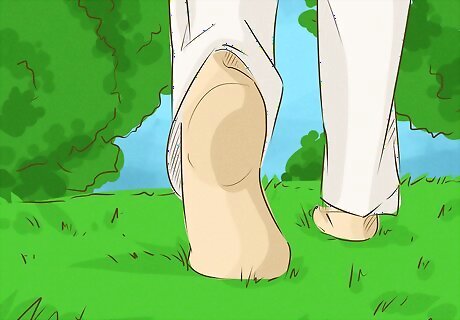
Take a mindfulness walk. Walking is a relaxing and diverting exercise. A mindful walk is even better because it is mindfulness in movement. To have a mindful walk, take notice of each step while you are walking. How do your feet feel on ground? In your shoes? Focus on your breath. Take notice of the environment. Take time to enjoy the environment around you. Benefits to a mindfulness walk include learning awareness in daily life and focusing your consciousness. Traditional, stationary mediation might be hard for some people, so mindful walking is a more active form of meditation. There are also the added health benefits of walking.
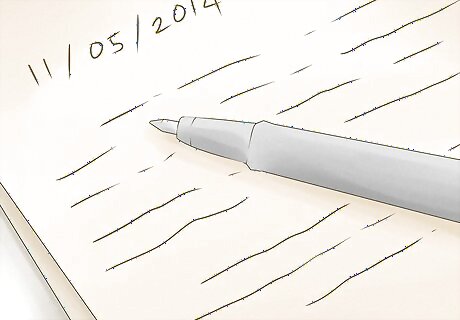
Record situations when you want to self-harm. Start a journal that describes each time you want to harm yourself. When you feel the urge to harm, write it down. Document when it happens and what happened before the urge arose. Writing it down will help identify patterns or feelings that lead to cutting. Also, journaling provides an outlet to share your feelings and process your thoughts.

Create a coping skill box. A coping skill box or kit is a container that you fill with supplies to help stop the urge to self-harm. Get a shoe box or small cardboard box and fill it with anything that you think will help you not want to cut yourself. This can be pictures of friends, family, or pets, a journal to write in, art supplies so you can make something artistic instead, inspiring quotes or lyrics that will make you feel better, a favorite CD, or any sort of object that will lift you spirits and take your mind off of cutting.

Find another outlet. Some people cut themselves because of too much anger, hate, frustration, or pain. If this is why you cut, try to find another outlet for your emotions. If you are angry or frustrated, find a pillow to punch, go outside and yell, rip up some paper, or squeeze a stress ball. You can even take up kickboxing classes or take a self-defense course. Any activity that will help you release the emotions you typically express through cutting will help you avoid cutting in the future. Finding the right outlet can take time. Try a few until you find one that fits your emotions. Keep in mind that it may change from situation to situation.
Practicing Positive Self Talk
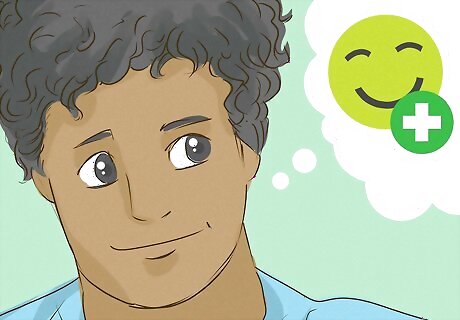
Listen for positive self-talk. Positive self-talk refers to the positive way that your inner voice talks to you and views yourself. This inner voice impacts your motivation, outlook, self-esteem, and overall well-being. Positive self-talk is a way to talk to yourself that will help you gain confidence, build a healthier lifestyle, and reduce negative thoughts. Positive self-talk can also help keep a health perspective on your emotions. Remind yourself that emotions and the urge to want to cut are just emotions and not fact. They will pass or can be improved. The feelings you are having that make you want to cut will not always be there.
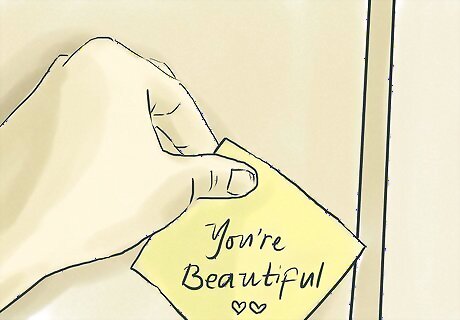
Leave reminders. One way to incorporate positive self-talk into your everyday life is to leave visual reminders around. Use post-it notes or taped pieces of paper to leave positive phrases about yourself around your living areas. You can also write messages on your mirror, on a window, or on dry erase boards. This way, you will see the reminders every day and it will help improve you mood. It will also help you see positive messages when you are thinking about cutting. Good examples of positive phrases include: I am lovable. I am special. I am confident. I can achieve my goals. I am beautiful/handsome. My feelings are just feelings. My emotions will not last forever. Emotions are not facts. Harming myself does not solve my problems. Harming myself might provide quick relief, but not long term relief. I can overcome my anger/sadness/anxiety without harming. I can trust someone with my feelings right now. I can seek support. I’m going to make it.
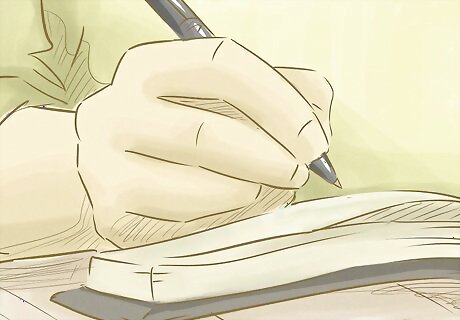
Start a thoughts journal. Positive self-talk will help you acknowledge and understand thought patterns that impact urges to self-harm. Learn to acknowledge your thoughts because they are often a habit. Some people find it helpful to create a journal to help record the daily thought processes. Writing them down allows you to critically think about your feelings and thoughts as well as process how to handle things differently. The goal is not to change your thoughts but to become aware of the thoughts. This will help you acknowledge them, which will help you not passively act on these negative thoughts that lead to self-harming behaviors. Try to write down the situation, thought, feeling, or emotion you have as well as any physical sensation such as energy, tightening of the stomach, and actions you do.

Assess your thoughts. Assessing your thoughts and thought process can help lead to more positive self-talk and less harmful thoughts that lead to cutting. Are your thoughts true? Look at your thought record and assess any similar situation you ended up in. Did you learn anything from these situations and what were the long term consequences? Did you handle any situations differently than other days? Did you act on negative thoughts? A good way to assess negative thoughts is to look for statements with words like should, ought, or must. These types of statements lead to messages of all or nothing. These negative, often harsh thoughts about yourself can lead to self-harm. Looking at your thoughts journal, what were some alternative thoughts you could have had? Write down the alternative and positive statements that undermine the negative thoughts you had. Ask a friend or trusted family member if you are unsure if thoughts are true.
Preventing the Next Episode
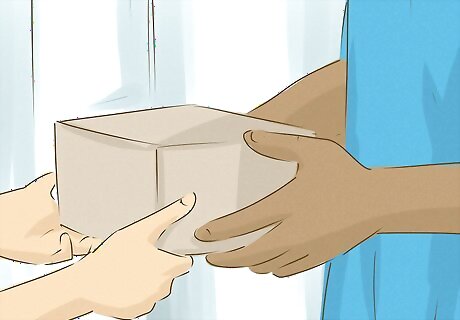
Remove triggering objects. In order to prevent another episode of cutting, you need to remove the tools that you use to do it. Get rid of any objects you have used before to self-harm. If you have to spend time searching for something to harm yourself with, you may be able to crush the impulse. The time to think about your actions or the added effort can act as deterrents. Don't keep sharp objects on your table and don't put razors in drawers or cupboards that you can easily access. If you do not yet feel able to throw out your tools, try to delay getting to them by keeping them wrapped up tightly and high up on hard-to-reach shelves. If possible, give them to someone else. This is a guaranteed way that they won't be find-able. You'll likely be angry initially, but when it passes, you'll be thankful that it stopped you from being able to harm yourself.

Identify and avoid your triggers. The moment you have the urge to harm yourself, stop and think of what has just occurred. These are your triggers. Remember them and try to avoid these situations. Sometimes, they can be predicted and if they can be predicted, they can be avoided. Common triggers can include problems with peers such as bullying and cyber bullying, pressure at school, feeling socially isolated, abuse, confusion around sexuality, and issues in your family. Some people are more likely to cut at certain times of the day. If you know that you're more prone to cutting in the morning, take extra caution just after you roll out of bed. Know yourself and what to do to handle the next urge. If you've just had an argument with somebody close to you, for example, and are having the urge to self-harm, stop and ask yourself what's making you feel this way: "I feel like harming myself because I've just had an argument with somebody I love, and it's making me feel really bad." Determine what in particular makes this situation trigger negative emotions, such as a certain feeling or maybe an action. Work on reducing this issue until you have it under control or completely diminished.

Acknowledge your success. It's important to celebrate progress you've made. Try marking a calendar with a preferred color on days you don't cut. At the end of each month, tally the number of days you didn't cut and write it on the bottom. Work to increase the number of days the following month.
Seeking Professional Help
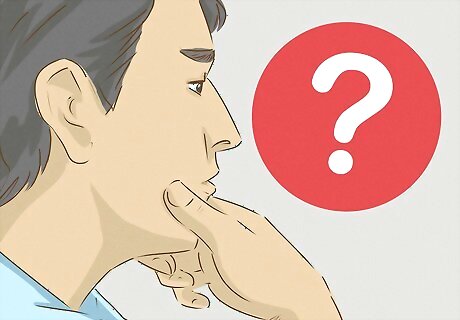
Look for an underlying cause. In some situations, cutting might be a symptom of another issue such as depression, anxiety, or other psychological disorder. Cutting often gains the person a sense of relief from intense feelings such as anger, guilt, anxiety, isolation, grief, or hopelessness. It can also be seen as an expression of those feelings and pain. Other reasons that people cut include a need for control over your body, especially when you feel out of control. Some people self-harm to feel something when feeling numb. Others do it as a response to trauma or other issues like anxiety and depression.
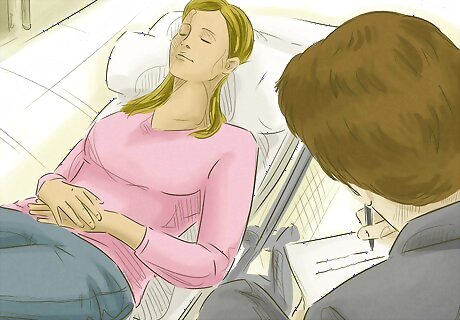
Talk to a professional. If you have trouble breaking the cycle of cutting through coping techniques or other methods, you might need professional help to change the situation. A counselor, clinical psychologist, or psychiatrist will talk to you about why you're harming yourself and they will talk with you about what you're feeling and how to change your behaviors in relation to these behaviors. Consider going to group therapy, where you'll be able to see that there are other people struggling with the same issue. If you're a minor, tell your parent or guardian that you need to see a mental health professional as soon as possible. Emphasize that this is an emergency. If you're an adult and have health insurance, call your primary care physician as soon as possible and ask for a referral to a therapist or psychologist who specializes in self-harm. If you're not insured, investigate free or low-cost mental health clinics in your area, or ask a member of your clergy for help if you are religious.
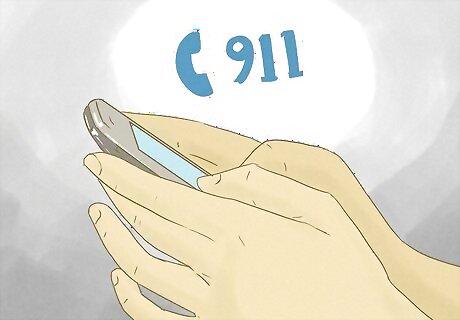
Seek immediate help. If you've harmed yourself to the point of severe injury, you need to seek medical help immediately. Severe injury is any cut that that bled for more than 10 minutes, a cut that won’t stop bleeding, or a scenario where you accidentally or intentionally nicked a major vein or artery. You should also seek help immediately if you are having thoughts of suicide.

Know the distinctions. Self-harm is not the same as suicide but the two are often mistaken for each other. A major difference is the intent to ending life. A person thinking of suicide often sees no other way out and wants to put an end to his or her life. Someone who self-harms, however, is often the exact opposite because the person intentionally harms themselves to feel alive or cope with life. Research does show people who self-harm are more likely to commit suicide later. This is often correlated with other factors such as depression, feeling as if there are fewer reason to live, or feeling hopeless. Make sure you take any suicidal thoughts seriously and seek help. Look for distinct signs of suicide, such as talking about wanting to die or to kill themselves, looking for a way to kill themselves, making statements about being hopeless, or talking about having no reason to live. If you or someone you love are thinking about suicide, get help. Call 988’' to talk to someone about helping the person who is contemplating it, or call the appropriate emergency services number if an attempt has already occurred.




















Comments
0 comment